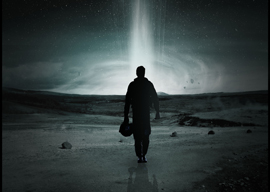
November 12, 2014

With the exception of the teeming masses of Philip K. Dick adaptations, science fiction movies (such as the new Interstellar) tend to be based on original screenplays rather than the genre’s classic novels.
One reason has been budgetary: mainstream novels, such as Gone Girl, consist mostly of people talking to each other, while sci-fi authors can dream up settings profligate to film.
Perhaps a more fundamental problem with filming a beloved sci-fi book is that nothing becomes dated faster than a vision of the future.
Nonetheless, I remain wholly enthralled by the young adult novels written around 1947-1963 by Robert A. Heinlein. A month ago, for instance, I picked up his 1950 book with the unpromising title Farmer in the Sky and was immediately amazed by the sheer professionalism with which Heinlein makes interesting his topic of, yes, agriculture in outer space.
Heinlein’s book has not proven terribly accurate. Yet you reread a 1950s sci-fi novel not to learn about the future, but because you enjoy the way people in the 1950s thought.
Few admire the expansive spirit of midcentury science fiction more than the Anglo-American Nolan brothers, writer-director Christopher and writer Jonathan (The Dark Knight, Memento).
Their Interstellar is an epic homage paying tribute to the Promethean age of space exploration and the science fiction that encouraged it. Getting to the moon by 1969, less than three score and ten years after the Wright brothers first flew their motorized kite, remains one of the more implausible tales in history. How”d we do that, anyway? How long would it take us 21st-century people to get back?
Matthew McConaughey stars as a lean, leather-jacketed rocket pilot named Coop (presumably a cross between Sam Shepard’s Chuck Yeager and Dennis Quaid’s Gordo Cooper in the 1983 Philip Kaufman astronaut movie The Right Stuff).
Interstellar attempts to combine 21st-century physics ideas about rotating black holes dilating time with 20th-century “Light this candle“ attitude. Interstellar is, among much else, an attempt to come up with some kind of science-y explanation for the trippy ending of Stanley Kubrick and Arthur C. Clarke’s 1968 film 2001: A Space Odyssey. But sci-fi fans will notice countless other influences from the grand tradition, such as Heinlein’s “juveniles.”
Christopher Nolan has long been a student of prestidigitation (as seen in his 2006 movie The Prestige), and there’s a certain amount of hand waving to speed Interstellar through a plot elaborate enough to have filled a 13-hour season on HBO. But movies move much more briskly than prestige TV dramas these days. To rocket through all these wormholes in 169 minutes, the Nolans gesture broadly in the direction of various classics of the sci-fi and sci-fact genres.
I found these salutes effective and enjoyable. On the other hand, if you are not a sci-fi fan, the mash-ups of venerable conceits may wear thin, and you may find the plot silly. Moreover, even if you are familiar with the stories to which Interstellar pays respect, be aware that the grimly determined Christopher Nolan isn”t a playful filmmaker interested in getting laughs or even smiles from viewers.
The film starts off on a future Earth that’s much like the one Heinlein’s hero left behind in Farmer in the Sky, where food is scarce but energy is abundant. (This seems strange today, but it resembles where our world seemed to be heading in 1950, before the green revolution and the energy crisis.) So what could have been more sensible than Heinlein shipping tens of thousands of surplus Earthlings off to become pioneering dirt farmers on Jupiter’s largest moon, Ganymede?
Well, OK, maybe that’s not the most reasonable thing to do with unlimited energy. But the point of Heinlein’s science fiction wasn”t to predict the world’s future, but to recount the settlement of America in order to inspire the next generation to follow their forebears” metaphorical footsteps into the galaxy. Thus Heinlein let you know what it was like to be an old-time sodbuster on the Great Plains frontier (but he left out all the boring old-time stuff).
Interstellar‘s Earth is much like the dismal future forecast in Farmer in the Sky. After Malthusian wars caused by mass hunger, the survivors on the Great Plains have adopted a quietist ideology in which school textbooks explain, to Coop’s disgust, that Apollo 11 was a fake to provoke the Soviets into overspending on pointless space flight.
But despite the Grapes of Wrath-level poverty the farmers endure, there are no shortages of oil or worries about carbon emissions (as in Rian Johnson’s recent Looper). The farmers drive around in huge 1990s pickup trucks. Instead, a mysterious “blight””perhaps some kind of inexorable, multiple host parasite”has killed off the wheat and even the okra, and is now slowly laying waste to corn, the last crop. When the blight kills the corn, mankind will starve.
Frustrated at being condemned to a life of farming after his early adventures in space, Coop insists to the schoolteacher of his daughter, a math prodigy:
“We”ve always defined ourselves by the ability to overcome the impossible. And we count these moments. These moments when we dare to aim higher, to break barriers, to reach for the stars, to make the unknown known. We count these moments as our proudest achievements. But we lost all that. Or perhaps we”ve just forgotten that we are still pioneers.”